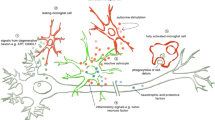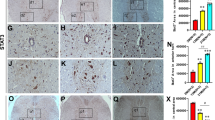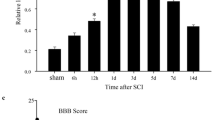Abstract
S100B is a calcium-binding protein that, in the nervous system, is mainly concentrated in glial cells. Although its biological role is still unclear, the protein is hypothesized, at high concentrations, to act in the pathogenesis of neurodegenerative processes, possibly through oxidative stress mechanisms. To investigate this hypothesis we studied the spinal cord of wobbler mice, an animal model of motor neuron degeneration. Using immunocytochemistry, we detected an overexpression of S100B in astrocytes of the cervical spinal cord of these animals. We also confirmed this finding by reverse transcriptase polymerase chain reaction. In the same spinal cord regions, scattered neurons appeared to be immunostained for 4-hydroxynonenal–modified proteins, an indicator of lipid peroxidation. This finding constitutes a sign of oxidative stress–induced neurodegeneration.
Similar content being viewed by others
REFERENCES
Falconer, D. S. 1956. Wobbler mouse. News Lett. 15:23.
Duchen, L. W., Falconer D. S., and Strich, S. J. 1966. Hereditary progressive neurogenic muscular atrophy in the mouse. J. Physiol. (Lond.) 183:53–55.
Papapetropoulos, T. A. and Bradley, W. G. 1972. Spinal motor neurons in murine muscular dystrophy and spinal muscular atrophy: a quantitative histological study. J. Neurol. Neurosurg. Psychiatr. 35:60–65.
Baulac, M., Rieger, F., and Meininger, V. 1983. The loss of motoneurons corresponding to specific muscles in the wobbler mutant mouse. Neurosci Lett. 37:99–104.
Duchen, L. W. and Strich, S. J. 1968. A hereditary motor neurone disease with progressive denervation of muscle in the mouse: the mutant "Wobbler." J. Neurol. Neurosurg. Psychiatry 31:535–542.
Leestma, J. E. 1980. Animal model of human disease: Werdnig-Hoffmann disease (infantile spinal muscular atrophy). Am. J. Pathol. 100:821–824.
Gonzales-Deniselle, M. C., Gonzales, S. L., and De Nicola, A. F. 2001. Cellular basis of steroid neuroprotection in the wobbler mouse: A genetic model of motoneuron disease. Cell. Mol. Neurobiol. 21:237–254. [Review].
Smith, R. G., Henry, Y. K., Mattson, M. P., and Appel, S. H. 1998. Presence of 4–hydroxynonenal in cerebrospinal fluid of patients with sporadic amyotrophic lateral sclerosis. Ann. Neu-rol. 44:696–699.
Pedersen, W. A., Fu, W., Keller, J. N., Markesbery, W. R., Appel, S., Smith, R. C., Kasarkis, E., and Mattson, M. P. 1998. Protein modification by the lipid peroxidation product 4–hydroxynonenal in the spinal cords of amyotrophic lateral sclerosis patients. Ann. Neurol. 44:819–824.
Cookson, M. R. and Shaw P. J. 1999. Oxidative stress and motorneurone disease. Brain Pathol. 9:165–186.
Shibata, N., Nagai, R., Miyata, S., Jono, T., Horiuchi, S., Hirano, A., Kato, S., Sasaki, S., Asayama, K., and Kobayashi, M. 2000. Nonoxidative protein glycation is implicated in familial amyotrophic lateral sclerosis with superoxide dismutase-1 mutation. Acta Neuropathol. 100:275–284.
Shibata, N., Nagai, R., Uchida, K., Horiuchi, S., Yamada, S., Hirano, A., Kawaguchi, M., Yamamoto, T., Sasaki, S., and Kobayashi, M. 2001. Morphological evidence for lipid peroxidation and protein glycoxidation in spinal cords from sporadic amyotrophic lateral sclerosis patients. Brain Res. 917:97–104.
Ait Ikhlef, A., Hantaz-Ambroise, D., Henderson, C. E., and Rieger, F. 2000. Influence of factors secreted by wobbler on neuronal and motoneuronal survival. J. Neurosci. Res. 59:100–106.
Hantaz-Ambroise, D., Blondet, B., Murawsky, M., and Rieger, F. 1994. Abnormal astrocyte differentiation and defective cellular interactions in wobbler mouse spinal cord. J. Neurocytol. 23:179–192.
Bigini, P., Bastone, A., and Mennini, T. 2001. Glutamate transporters in the spinal cord of the wobbler mouse. Neuroreport 12:1815.
Hantaz-Ambroise, D., Jacque, C., Ait Ikhlef, A., Parmentier, C., Lerclerc, P., Cambier, D., Zadigue, G., and Rieger, F. 2001.Specific features of chronic astrocyte gliosis after experimental central nervous system (CNS) xenografting and in wobbler neurological mutant CNS. Differentiation 69:100–107.
Heizmann, C. W. 1999. Ca2+-binding S100 proteins in the central nervous system. Neurochem. Res. 24:1097–1100 [Review].
Donato, R. 2001. S100: A multigenic family of calcium-modulated proteins of the EF-hand type with intracellular and extracellular functional roles. Int. J. Biochem. Cell Biol. 33: 637–668 [Review].
Hu, J. and Van Eldik, L. J. 1996. S1003 induces apoptotic cell death in cultured astrocytes via a nitric oxide-dependent pathway. Biochem. Biophys. Acta 1313:239–245.
Huttunen, H. J., Kuja-Panula, J., Sorci, G., Agneletti, A. L., Do-nato, R., and Rauvala, H. 2000. Coregulation of neurite outgrowth and cell survival by amphoterin and S100 proteins through receptor for advanced glycation end products (RAGE) activation. J. Biol. Chem. 275:40096–40105.
Keller, J. N. and Mattson, M. P. 1998. Roles of lipid peroxidation in modulation of cellular signaling pathways, cell dysfunction, and death in the nervous system. Rev. Neurosci. 9:105–116. [Review].
Zarcovic, N., Zarcovic, K., Shaur, R. J., Stolc, S., Schlag, G., Redl, H., Waeg, G., Borovic, S., Loncaric, I., Juric, G., and Hlavka, V. 1999. 4–Hydroxynonenal as second messenger of free radicals and growth modifying factor. Life Sci. 67:1901–1904.
Migheli, A., Cordera, S., Bendotti, C., Atzori, C., Piva, R., and Schiffer, D. 1999. S-100beta protein is upregulated in astrocytes and motor neurons in the spinal cord of patients with amy-otrophic lateral sclerosis. Neurosci. Lett. 261:25–28.
Yang, Q., Hamberger, A., Wang, S., Dahalstrom, A., and Haglid, K. C. 1995. S-100 beta has a neuronal localisation in the rat hindbrain revealed by an antigen retrieval method. Brain Res. 696:49–61.
Sayre, L. M., Zelasko, D. A., Harris, P. L., Perry, G., Salomon, R. G., and Smith, M. A. 1997. 4–Hydroxynonenal-derived advanced lipid peroxidation end products are increased in Alzheimer's disease. J. Neurochem. 68:2092–2097.
Markesberry, W. and Carney, J. M. 1999. Oxidative alteration in Alzheimer's disease. Brain Pathol. 9:133–146.
Author information
Authors and Affiliations
Corresponding author
Rights and permissions
About this article
Cite this article
Corvino, V., Businaro, R., Concetta Geloso, M. et al. S100B Protein and 4-Hydroxynonenal in the Spinal Cord of Wobbler Mice. Neurochem Res 28, 341–345 (2003). https://doi.org/10.1023/A:1022345720852
Issue Date:
DOI: https://doi.org/10.1023/A:1022345720852




